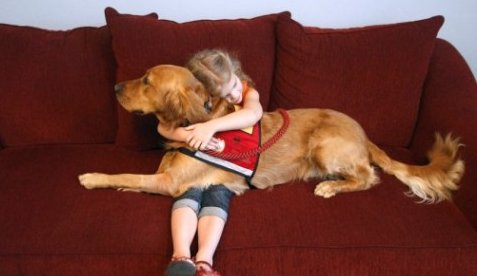Why People Find Dogs Comforting
During a forensic interview, the presence of a facility dog can be a source of comfort to children, and may allow them to more easily describe abuse they have experienced or a crime they have witnessed. Research has shown that a dog’s gaze or physical contact increases oxytocin in humans, and that oxytocin increases trust. Having a dog lying calmly on the couch next to a victim can reduce anxiety, and promote feelings of contentment and security. (1,2)
When people describe a traumatic event to a stranger, they often suffer re-traumatization. Some children experience involuntary physical responses to this stress, which can affect their ability to speak. If the child cannot describe what happened, this can negatively affect the investigation.
See David A. Crenshaw, Ph.D., ABPP – Guidelines for Attorneys and Judges to Recognize and Respond to Trauma Stress Reactions of Child Witnesses/Victims when Giving Testimony.

Courthouse facility dog Russell, trained by Assistance Dogs of the West, works at the Southern Arizona Child Advocacy Center with Director Kathy Rau.
The Initial Greeting
Most parents or guardians of a child victim or witness are anxious about the prospect of their child undergoing a forensic interview. They may think that the child will be interrogated by the police, and that the child will feel distressed by the experience.
When greeting the family, tell them that a professionally trained facility dog is available for the child, and determine whether the dog would be a welcome companion during the interview. Many children are pleasantly surprised when they hear about the dog, and they become more focused on meeting the dog rather than on the apprehension that they may feel about the interview. In addition, most parents are impressed by this extra measure taken to comfort the child. Both the child and the parents should be consulted about whether the dog should be present during the interview.
Before the Interview
Introduce the dog to the child, explain why the dog is there, and take a few minutes to allow the child and dog to interact and build rapport. Show the child some of the “tricks” the dog can do, and teach the child how to give the dog these commands. Most facility dogs will comply with commands even from small children. This makes a child feel empowered, and most children choose to have the dog present during the interview.
During the Interview
- We have found that the dog is more effective at calming the child if there can be physical contact between them. This is why it’s important to make it possible for the child and the dog to sit together on a couch.
- Keep the dog on a leash during the interview because many children like to hold or play with the leash to reduce stress.
- Use the dog to refocus a child who has become distracted or hyperactive. Tell the child that the dog enjoys being petted. Child psychologist David Crenshaw, who works with facility dogs, believes that the rhythmic action of petting a dog is self-calming and facilitates the child’s ability to engage in conversation.
- Should the child become upset, ask if he/she would like to give the dog a hug. This allows the dog to provide comfort when the interviewer cannot.
Older Children and Teenagers
Although older children and teens may seem reserved about having the dog with them, they often resort to petting the dog when the conversation becomes more stressful. Here are two examples.
Our courthouse facility dog, Molly, sometimes assists child interview specialist, Gina Coslett, who works at a Child Advocacy Center. One day when we were picking Molly up from work, Gina told us about an interview where Molly’s presence had made a difference.
The interview lasted about two hours, and the 15-year-old girl petted Molly throughout their discussion. At one point in the middle, Molly thought the interview was over and hopped off the couch and went over to Gina expecting to be led outside. Gina asked the girl if she would like to have Molly lie beside her again. The girl declined, but when the questioning resumed, she stopped speaking and started scratching her arm. The girl explained that she scratched when she was nervous. When the brisk scratching continued, Gina asked Molly to get back on the couch and to lie down by the girl again. The girl stopped scratching, resumed petting Molly, and was able to finish the interview.
On another occasion, a teenage boy reluctantly agreed to have Molly accompany him into the interview room. Gina asked him if he wanted Molly up on the couch next to him and he declined, so the dog curled up on a mat on the floor. However, when the interview began to ask about details of his abuse, the boy interrupted Gina and told her that he thought Molly would be more comfortable on the couch with him. Molly jumped up next to him, and he was able to resume the interview.
After the Interview
The dog may be available to keep the child company after the interview ends. Most children and their families leave the office thinking and talking about the dog instead of the reason for the interview. Children even ask to return for another visit. By helping families choose to continue with the investigation, a dog’s presence can help an investigation reach a successful conclusion.

